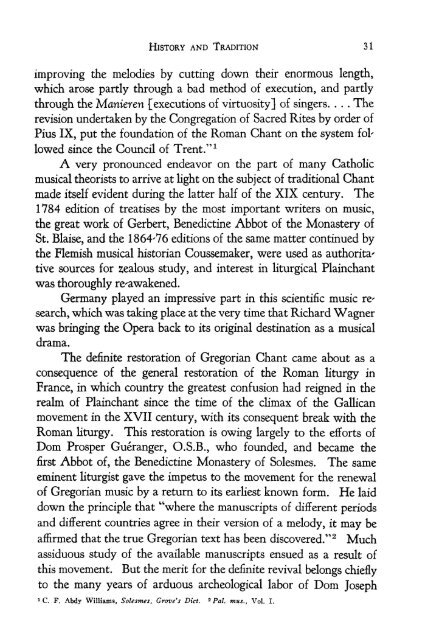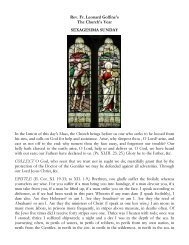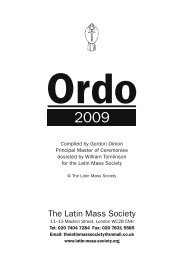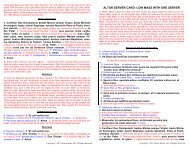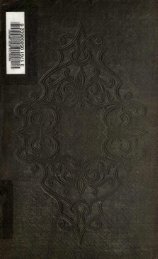The Spirit of Gregorian Chant - Church Music Association of America
The Spirit of Gregorian Chant - Church Music Association of America
The Spirit of Gregorian Chant - Church Music Association of America
Create successful ePaper yourself
Turn your PDF publications into a flip-book with our unique Google optimized e-Paper software.
HISTORY AND TRADITION 31<br />
improving the melodies by cutting down their enormous length,<br />
which arose partly through a bad method <strong>of</strong> execution, and partly<br />
through the Manieren [executions <strong>of</strong> virtuosity] <strong>of</strong> singers. . . . <strong>The</strong><br />
revision undertaken by the Congregation <strong>of</strong> Sacred Rites by order <strong>of</strong><br />
Pius IX, put the foundation <strong>of</strong> the Roman <strong>Chant</strong> on the system fol"<br />
lowed since the Council <strong>of</strong> Trent." 1<br />
A very pronounced endeavor on the part <strong>of</strong> many Catholic<br />
musical theorists to arrive at light on the subject <strong>of</strong> traditional <strong>Chant</strong><br />
made itself evident during the latter half <strong>of</strong> the XIX century. <strong>The</strong><br />
1784 edition <strong>of</strong> treatises by the most important writers on music,<br />
the great work <strong>of</strong> Gerbert, Benedictine Abbot <strong>of</strong> the Monastery <strong>of</strong><br />
St. Blaise, and the 1864-76 editions <strong>of</strong> the same matter continued by<br />
the Flemish musical historian Coussemaker, were used as authorita'<br />
tive sources for zealous study, and interest in liturgical Plainchant<br />
was thoroughly reawakened.<br />
Germany played an impressive part in this scientific music re'<br />
search, which was taking place at the very time that Richard Wagner<br />
was bringing the Opera back to its original destination as a musical<br />
drama.<br />
<strong>The</strong> definite restoration <strong>of</strong> <strong>Gregorian</strong> <strong>Chant</strong> came about as a<br />
consequence <strong>of</strong> the general restoration <strong>of</strong> the Roman liturgy in<br />
France, in which country the greatest confusion had reigned in the<br />
realm <strong>of</strong> Plainchant since the time <strong>of</strong> the climax <strong>of</strong> the Gallican<br />
movement in the XVII century, with its consequent break with the<br />
Roman liturgy. This restoration is owing largely to the efforts <strong>of</strong><br />
Dom Prosper Gueranger, O.S.B., who founded, and became the<br />
first Abbot <strong>of</strong>, the Benedictine Monastery <strong>of</strong> Solesmes. <strong>The</strong> same<br />
eminent liturgist gave the impetus to the movement for the renewal<br />
<strong>of</strong> <strong>Gregorian</strong> music by a return to its earliest known form. He laid<br />
down the principle that "where the manuscripts <strong>of</strong> different periods<br />
and different countries agree in their version <strong>of</strong> a melody, it may be<br />
affirmed that the true <strong>Gregorian</strong> text has been discovered." 2 Much<br />
assiduous study <strong>of</strong> the available manuscripts ensued as a result <strong>of</strong><br />
this movement. But the merit for the definite revival belongs chiefly<br />
to the many years <strong>of</strong> arduous archeological labor <strong>of</strong> Dom Joseph<br />
i C. F. Abdy Williams, Solesmes, Grove's Diet.<br />
2 Pal. mus., Vol. I.


